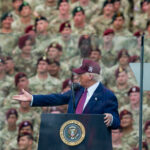I’m selfishly writing this article for the benefit of my parents.
My parents live in Sioux Falls, South Dakota. My mom is a nurse practitioner in psychiatry with an advanced degree in nursing. My step-dad is the CEO of a successful small business that focuses on carpentry. They are both incredibly smart, out-going, people that support me in all of my wild endeavors. They constantly want to know more about what I do as a research assistant in nuclear issues, but, at a very fundamental level, they do not understand. They can tread water for a while when I make wonky assertions, but they simply cannot keep up. It is not an issue of intelligence, nor is it a generational one (my mom knows an inordinate amount about Migos and Bad Bunny and twerking, and my step-dad frequently belts out lyrics to “thank u, next”). Rather, it is an issue of access, specifically, an issue of access vis-à-vis language.
While it is true that several DC think tanks have created fact sheets, glossaries, and even curriculums explaining national security terms, they are still relatively difficult to find and consume without causing eyes to glaze over. In fact, in order to access this information, one must already have a relatively substantial background in political science/national security. Even knowing where to find these “helpful guides” is a challenge because one must also already know who is producing said information. To add even more of a kicker, often the organizations themselves have a name that is only an acronym. It’s an alphabet soup from hell, and it is scaring away people who actively want to participate.
So, with that said, I wanted to create a no-nonsense, easy to use, easy to find “top 25 guide” to language and acronyms that flood the DC national security sphere. The goal is to KISS (keep it simple, stupid). All bullshit aside, people want to care, and this guide wants to help.
1. Ballistic vs. Cruise: Ballistic and cruise are two different types of missiles. If an acronym has “BM” it most likely refers to a ballistic missile, whereas “CM” is a cruise missile. Ballistic missiles are launched directly into the high layers of the atmosphere, eventually leaving the atmosphere (Think: “bye, bye ballistic). After the initial launch, a ballistic missile begins an “unpowered flight” (i.e. only using gravity to travel). It follows an arch pathway, and after reaching its peak, the warhead detaches from the rest of the missile to hit its target. A cruise missile, however, is guided throughout its entire flight (i.e. by an engine). It does not leave the atmosphere and can change its path to hit its target. Both types of missiles can carry conventional and nuclear warheads and both are capable of making huge ass explosions.
2. ICBM: ICBMs are “Intercontinental Ballistic Missiles.” Ballistic missiles are broadly categorized by how far they can travel, so, in reality, it doesn’t matter how big the size of Trump’s button is (someone should probably tell him). ICBMs have the longest range of ballistic missiles, and other missile categories include IRBM (intermediate range ballistic missile), MRBM (medium-range ballistic missile) and SRBM (short-range ballistic missile). SLBMs refer to ballistic missiles launched from a submarine. Once you know something is a ballistic missile, it’s pretty easy to figure out the acronym: Range abbreviation (or sometimes launch platform) + BM. Conversely, cruise missiles are often classified by their speed: subsonic, supersonic, hypersonic.
3. Solid vs. Liquid Fuel: All missiles require fuel. As the name would suggest, liquid fuel consists of fuel and an oxidizer in a, you guessed it, liquid state, which are then combined in a chamber and ignited for takeoff. Solid fuel is a fuel and oxidizer mixture in a (surprise, surprise) solid form that is ignited. Liquid fuel flow can be controlled and the engine can turn on and off as needed, whereas solid fuel cannot be turned off. Solid fuel is generally viewed as simpler, safer, and cheaper. Liquid fuels in missiles can cause delays in preparedness and long-term storage and maintenance. All you need to remember is that liquid is lame.
4. MIRV: “Multiple Independent Targetable Reentry Vehicle” is a missile payload, usually on an intercontinental nuclear missile, that contains several warheads, each of which are capable of being aimed to hit a different target, or sometimes acting as a “dummy’ warhead. This feature is super useful in evading missile defense systems. Basically, when the warhead is reentering the atmosphere, the enemy will think “hey, one singular warhead, let’s take it out.” But, surprise bitch, multiple warheads emerge, going every-which-way… Good luck trying to stop all of those bad boys.
But, surprise bitch, multiple warheads emerge, going every-which-way… Good luck trying to stop all of those bad boys.
5. SAM: “Surface to Air Missile.” SAMs are launched from the ground to destroy aircraft or other missiles. SAMs are really popular in the Middle East, so an easy way to remember this weird acronym is “SAM in the sand.”
6. BMD: “Ballistic Missile Defense” is a system, weapon, or technology that is used to detect, track, intercept, and destroy missiles using satellite sensors, radar detection and intercepting kill vehicles. Spoiler alert: this sounds a lot more bad ass than it actually is, and most of the time the systems don’t really work all that well. BMD systems can, in theory, adapt to different ranges and types of missiles as well as different missile trajectory phases and can be used either inside or outside the Earth’s atmosphere. The latest sexy BMD talk has been around space-based interceptors and lasers… but please see above spoiler alert before getting too excited.
7. Interceptor: Interceptors are a type of missiles used in BMD systems. The interceptor has a rocket and a “kill vehicle” and once an incoming adversary missile is detected (via radars and sensors) the interceptor launches, the kill vehicle separates and tries to track and collide with the incoming warhead. It is essentially the equivalent of trying to stop a bullet by hitting it with another bullet, and why BMD systems are so often ineffective.
8. Triad: The nuclear triad often referred to solely as the “triad”, is a three-pronged force structure that consists of nuclear missiles on the ground (silos/ICBMs), submarines (SLBMs), and in strategic aircraft. It evolved more from politics than strategic needs, so its necessity is really up for debate. Sometimes, an argument in favor of the triad is the land-based ICBMs will serve as a “sponge” to absorb a first nuclear strike. But, most land-based ICBMs are located in the Midwest… and as a proud South Dakotan, I can’t really condone this thinking (read: please don’t nuke us). All in all, the triad has played a large role in shaping nuclear strategy since the Cold War.
9. SSBN: SSBN is the US Navy classification for nuclear-powered, ballistic missile-carrying submarines. These are also known as “Trident” submarines, which I think could be a beautiful plot twist for a modern day “Little Mermaid.” King Triton replaces his trident and hitches a ride a sub decked out with nukes… What now Ursula?
10. Control System: Every missile has a type of guidance, or control, system that works to keep the missile in the correct flight path. It essentially guides and stabilizes the missile during flight to ensure the missile hits its accurate target. Usually, control systems function by means of radar or radio. Pretty simple: the control system controls the missile.
11. CVID: “Complete, Verifiable, Irreversible Dismantlement” refers mostly to North Korean nuclear diplomacy discussions. While it has seen a resurgence with the recent Trump-Kim summit, experts believe the policy has been around since the Bush administration. I would warn against thinking too optimistically about Trump and Kim’s love letters, however, because there is still A LOT of work to be done on this front before it becomes a reality.
12. Nonproliferation: Often referred to as “nonpro,” aims to prevent the increase and/or spread of weapons of mass destruction. Vertical proliferation refers to an increase of arsenals, and horizontal proliferation refers to more countries developing arsenals. Nonpro, at a very fundamental level, means “no more nukes.”
13. STRATCOM: “US Strategic Command,” is in charge of the US nuclear arsenal. Most abbreviations that end in “COM” refer to one of ten unified commands through the Department of Defense that are strategically located around the globe. Commands are where the military runs things. Each command has a commander that serves as the senior leader of unified military forces from across all four branches (Army, Navy, Air Force, Marines) that are located at a command.
14. JSOC: “The Joint Special Operations Command” is part of the larger special operations command and includes members from all four branches of the military. The branch is designed to study special operations requirements and techniques, and to plan and conduct joint special operations exercises. Special operations are so special that they are often very secret and not talked about publicly.
15. KJU: Acronym for Kim Jong-Un, the supreme leader of North Korea since 2012. I personally think this would also be a great name for a rap group.
16. DPRK: Acronym for the “Democratic People’s Republic of Korea” aka “North Korea.” (Yes, literally everything has an acronym in national security.)
17. KSA: Acronym for the “Kingdom of Saudi Arabia,” Similarly, “PRC” refers to the “People’s Republic of China.” “USA” refers to the “United States of America.” We’re apparently collectively pretty bad at keeping official names short.
18. Dual-Use: Dual-use technology refers to goods, products, and technologies that are normally used for civilian purposes, but could potentially have military applications. Literally, a technology that has two uses.
19. ISR: “Intelligence, surveillance, and reconnaissance,” which are principle elements in US defenses. It’s a classification for various systems that collect and process information needed by national security personnel. For example, creeping your ex on social media could be classified as a type of ISR.
20. OSINT: “Open source intelligence,” Information that is publicly available (i.e. not classified). It’s OPEN to the public… See? Acronyms aren’t that hard.
21. UAV: “Unmanned Aerial Vehicle” is an aircraft that is piloted by remote controls and onboard computers. It can have varying degrees of autonomy (i.e. ability to fly without a controller). They are informally referred to as drones… I’ve also heard them called “killer robots” which is terrifying.
22. AWACS: “Airborne Early Warning and Control System” also referred to as “AEW&C.” It is an airborne radar system used to detect aircraft, ships, and ground vehicles to help better direct aircraft strikes and fighters. They are also used to carryout surveillance. AWACS can detect adversaries at a much greater distance than ground-based radars. I included this acronym solely because I think it’s fun to say “AWACS.”
23. Amphibious: Amphibious warfare is an offensive military strategy that uses naval forces to launch ground and air attack against hostile shores. It originated in World War II (WWII) and is mainly used by Marines in modern warfare. It’s military equipment that, like a frog, can go from water to land.
24. COIN: “Counterinsurgency” refers to any efforts (military or political) that are taken to stop guerilla or revolutionary forces. Essentially, it aims to stop and contain rebellions. The Vietnam War is a popular example of counterinsurgency. An easy way to remember COIN is that, often, COIN is incredibly expensive and takes a long time… COIN costs a lot of coins.
25. R&D: “Research and Development,” refers to the innovation process by corporations, governments, and militaries when they are attempting to develop new services or products or trying to improve the existing ones. Emerging technologies are often in the R&D phase. Whereas R&B is to making love, R&D is to making tech. (Yes, I also physically cringed at that analogy… Sorry mom.)














